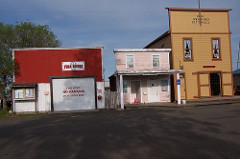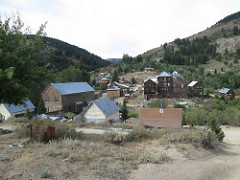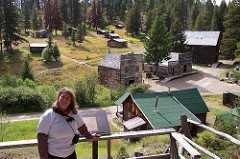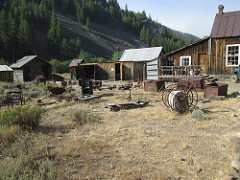



Advice for Traveling Around the USA Camping & Hiking
Do you want to travel around the USA, camping and touring and hiking and
what not? Here's some advice that I wish I had had when I started traveling
in the USA, by motorcycle or otherwise:
- National parks, national forests, national grasslands, national
monuments and Bureau of Land Management lands are all public lands
managed by the federal government. Most have camp sites - but not all
do.
- You are not permitted to camp rough - outside of designated camp sites
and camp grounds - in national parks. That includes a
prohibition on camping in parking lots. You are permitted to
camp rough in national forests and BLM-managed lands, unless there is
signage that says otherwise, and it's usually quite easy to find a site
that someone else has used - just go down a dirt road in a national
forest or BLM land and you will find such. Rough camping does not have
an official, metal-lined fire pit nor a picnic table. You do not have to
pay a fee to camp rough, but you do need to have a pass to be on the
land. Forest Service regions offer localized passes and you can find
information about those on the respective forest and grassland websites.
But your
best bet is to buy an annual inter-agency pass: it makes things
way easier and more economical, and it gives you access to all national
public lands, including national parks (it covers your entrance fee).
- State parks are managed by an individual state government (Kentucky,
Oregon, etc.). An inter-agency pass for national parks, national
forests, etc. will not get you into a state park, or vice versa. Most,
but not all, state parks offer camping - it's more expensive than
camping in a national park, but you get far more services (often, a
heated bathroom with showers and flush toilets - even wi-fi!). You are not
permitted to camp rough - outside of designated camp sites and camp
grounds - in state parks. That includes a prohibition on camping in
parking lots. Camp sites are often right next to each other, with no
privacy - but that's how the camping in national parks is as well.
- In general: camping in state parks is the most expensive of public
land camping because it offers the most amenities - flush toilet,
showers, perhaps even a tiny grocery store, and maybe even wi-fi.
Camping rough on BLM or national forest land is the cheapest, as it's
free, but you have nothing, no picnic table, not even a pit toilet.
National parks usually offer bathrooms with flush toilets, as well as
faucets with drinking water, in the drive-in camping area, but no
showers (or they have them but they cost extra), and pit toilets in back
country camping areas. Most national forest campgrounds have only pit
toilets, not flush toilets, and may or may not have a faucet with
drinking water or a water pump, but they are usually in a really scenic
spot an have a good amount of space between campsites (it's why they are
my favorite).
- In high season in the USA, from the Thursday before Memorial Day
weekend (Memorial Day is the last Monday in May) through Labor Day
(that's the first Monday in September), every reservable camp site
that's on the coast or in a coastal state, or in or near a National
Park, is reserved many, many days in advance, even weeks in advance, and
the first-come, first-served sites in these places may fill up by 10 in
the morning. This is also true of most state park campgrounds. Know your
camping or other accommodation options in advance for the places where
you will travel, and if you can make reservations, do it! That said, we
have often found a campsite on a holiday weekend if we show up at such a
campground on a Sunday night - a few people always go home early.
- National parks weren't created to drive through; they were created to
hike through and camp in. If all you are going to have time to do is to
drive in and have a look around from a parking lot, then look online at
what all of the lookout points and popular stops in national parks
offer. For instance, there really isn't much to see by just driving
through Yosemite National Park - if all you want to do is drive through
and stop at a few places for a few minutes, choose another, free pass to
get over the Sierras. I don't think Mount Rainer National Park is worth
just a drive in-drive out visit - I think you need to plan for at least
three hours of hiking in order to make a visit worth it. By contrast, I
think it's totally worth it to pay the entrance fee and just drive
through Crater Lake National Park. No matter how much time you want to
spend in a national park, know what there is to see and do there well
before you arrive. Is there a not-to-be-missed ranger program you would
want to see? If you aren't going to hike or see a program, is the view
spectacular and worth the crowds and the drive in a long line of
traffic? A little online research will tell you this. You may find that
driving through a national park, or to just a popular viewpoint, isn't
worth the traffic jam, smog, noise and wait time.
- Download national park and national forest maps before you leave on
your trip, or buy paper versions. You want maps that show all paved
roads in the park or forest, as well as all camp sites in the park or
forest. You may want maps that show hiking too; many maps will tell you
if hikes are easy, moderate or hard, approximately how long they will
take, and what there is to see. Getting a national park map at the
entrance isn't really helpful, and you don't want to waste time in a
national park parking lot trying to figure out which hike to take.
- For a national park in a coastal state, really, really popular
national park elsewhere (Mount Rainier, Yellowstone, Yosemite, Arches,
etc.), during high season, you need to get in line at the entrance to
enter the park by 9 a.m. on Thursday, Friday, Saturday or Sunday - even
earlier is better. If you aren't there by 9 a.m., don't bother going at
all.
- Some places in the USA - very few, however - have county parks that
offer camping. These offer bathrooms with flush toilets and, often,
showers as well. Camp sites are often right next to each other, with no
privacy - but not always (Wilkerson county park in Clark County and some
of the county parks in Josephine County, all in Oregon, are destination
campgrounds - beautiful!).
- Private campgrounds vary hugely in terms of price, amenities and
quality. Some even offer Wi-fi. Not all allow tent camping. Many don't
allow people to sleep in their cars or trucks. I hate them but,
sometimes, you just don't have any choice.
Also see:
My favorite North American Ghost towns / historic
mining towns / pre-1900s towns
Saving Money with Park Passes in the USA
Forest
Grove, Oregon area day hikes
Backpacking start points near
Portland, Oregon (PDX)
Forest Grove, Oregon area day hikes
(Washington County, Yamhill County, Tillamook County)
More Oregon and Washington
suggested short motorcycle routes
Return to the broads abroad home page
Disclaimer
Any activity incurs risk. The author assumes no responsibility for the use
of information contained within this document.
A Broad Abroad | contact me
The content of this page is by
by Jayne Cravens, 2020, all rights reserved







